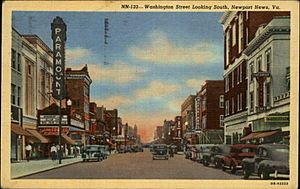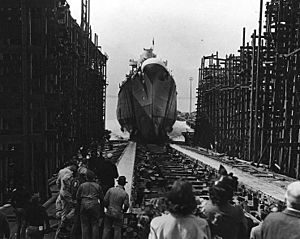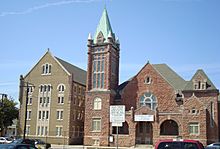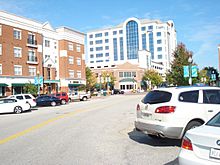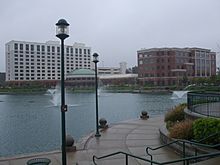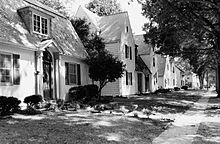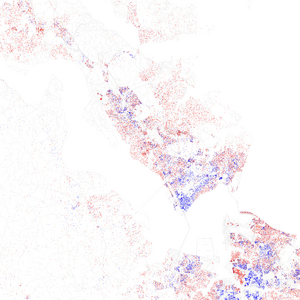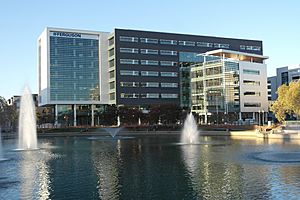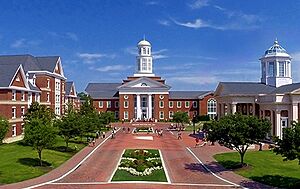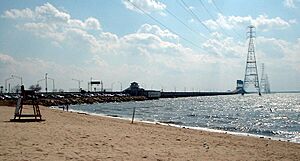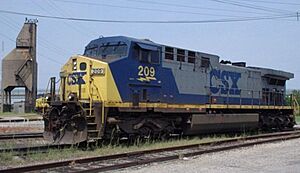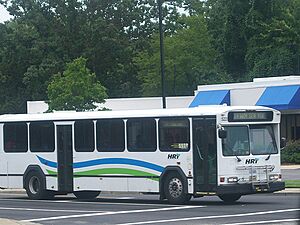Newport News, Virginia facts for kids
Quick facts for kids
Newport News, Virginia
|
|||
|---|---|---|---|
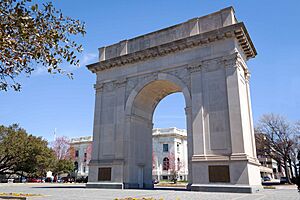
|
|||
|
|||
| Country | United States | ||
| State | Virginia | ||
| Settled | 1691 | ||
| Incorporated | 1896 | ||
| Area | |||
| • Independent city | 119.62 sq mi (309.81 km2) | ||
| • Land | 68.99 sq mi (178.68 km2) | ||
| • Water | 50.63 sq mi (131.14 km2) 42.4% | ||
| Elevation | 15 ft (5 m) | ||
| Population
(2020)
|
|||
| • Independent city | 186,247 | ||
| • Rank | 140th In the United States 5th In Virginia |
||
| • Density | 2,699.62/sq mi (1,042.33/km2) | ||
| • Urban | 1,439,666 | ||
| • Metro | 1,672,319 | ||
| Time zone | UTC−5 (EST) | ||
| • Summer (DST) | UTC−4 (EDT) | ||
| ZIP code |
23601-23609
|
||
| Area code(s) | 757, 948 | ||
| FIPS code | 51-56000 | ||
| GNIS feature ID | 1497043 | ||
Newport News is a city in southeastern Virginia, United States. It's an independent city, meaning it's not part of a county. In 2020, about 186,247 people lived there. This makes it the fifth-largest city in Virginia.
Newport News is located in the Hampton Roads area, right at the end of the Virginia Peninsula. It sits on the northern shore of the James River, where the river meets the big harbor of Hampton Roads. The city's economy is strongly linked to the military, with many people working at Newport News Shipbuilding and Joint Base Langley–Eustis. Its location on the water also makes it a hub for the boating industry and a key spot where trains meet ships at the Newport News Marine Terminals. Major highways like Interstate 64 connect it to other cities in Hampton Roads.
Contents
- What's in a Name? The Story of Newport News
- Newport News Through Time
- Where is Newport News?
- Who Lives in Newport News?
- Newport News' Economy
- Culture and Fun in Newport News
- Parks and Outdoor Activities
- Sports in Newport News
- Learning in Newport News
- Religion in Newport News
- Media and News
- Getting Around Newport News
- Famous People from Newport News
- Sister Cities
- Images for kids
- See also
What's in a Name? The Story of Newport News
The area around the mouth of the James River was first called Newportes Newes way back in 1621. The exact reason for the name Newport News isn't completely clear, but it's the oldest English city name in the Americas!
One popular story says the name comes from Captain Christopher Newport. He was an important captain who brought supplies to the early Jamestown colonists. After a very tough winter in 1609–1610, some colonists were leaving to go back to England. But then, Captain Newport arrived with more supply ships and a new governor, Thomas West, 3rd Baron De La Warr. The governor told them to turn around and go back to Jamestown. So, the community might have been named for Newport's "good news" (or "newes").
Another idea is that "news" might have been an old English word meaning "new town." Some even say the "New" part came from the original settlement being rebuilt after a fire.
Long ago, the name was sometimes written as "Newport's News." Over time, it changed to "Newport News," which is how we know it today.
Newport News Through Time
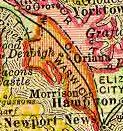
Early European Settlement
After Jamestown, Virginia was founded in 1607, English settlers started exploring and living in the areas near Hampton Roads. In 1610, a village called Kecoughtan was settled. Soon, settlers began clearing land along the James River for farms, including the area that is now Newport News.
In 1634, the English colony of Virginia had about 5,000 people. It was divided into eight areas called shires of Virginia. The Newport News area became part of Warwick River Shire, which later became Warwick County in 1637.
A City is Born: Railroads and Shipyards
Newport News was mostly farms and a small fishing village until after the American Civil War. Then, things changed quickly! In 1881, a man named Collis P. Huntington started a huge development project. He extended the Chesapeake and Ohio Railway to Newport News. This allowed trains to bring West Virginia bituminous coal to the port, where it could be shipped by sea.
Within a few years, Huntington and his friends also built a very large shipyard. This shipyard, now called Newport News Shipbuilding, became one of the biggest in the world. It was first built to make boats for moving goods from trains to ships. But when President Theodore Roosevelt decided to create a powerful Great White Fleet, the shipyard started building warships.
Newport News officially became a city in 1896.
Growing and Changing in the 1900s
Other members of the Huntington family also helped Newport News grow. Collis Huntington's nephew, Henry E. Huntington, led the shipyard for a while. Huntington Park, a large park, is named after him.
Collis Huntington's son, Archer M. Huntington, and his wife, Anna Hyatt Huntington, started The Mariners' Museum in 1932. They also created a beautiful park and Mariners' Lake around it. Today, the Mariners' Museum is one of the largest and best maritime museums in the world, filled with amazing artifacts about ships and the sea.
In 1958, the cities of Warwick and Newport News decided to join together. They chose the name Newport News, making it the third-largest city in Virginia at the time. This merger brought the area back to roughly its original size from before 1896.
After World War II, many new homes and businesses were built in the western and northern parts of the city. This was a common trend across the country as people moved to suburbs.
In 1989, the U.S. Navy named a submarine after the city: the USS Newport News. The city even had a song written about it!
Newport News in the 2000s
City leaders have been working hard to make downtown Newport News lively again. They've been renovating old buildings and building new homes and businesses. New areas like City Center at Oyster Point and Port Warwick have been developed. These places offer new homes, shops, and restaurants, and even host festivals and events.
Where is Newport News?
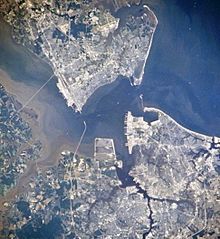
Newport News is located at 37°4′15″N 76°29′4″W / 37.07083°N 76.48444°W. The city covers about 120 square miles (309 square kilometers). About 69 square miles (178 square kilometers) is land, and 51 square miles (131 square kilometers) is water, making water a big part of the city's area!
The city is on the Peninsula side of Hampton Roads, which is a large natural harbor near the Atlantic Ocean. The Hampton Roads area is a big metropolitan area, meaning it includes many cities and counties that are connected. Newport News is one of the main business centers on the Peninsula.
Newport News shares land borders with James City County to the northwest, York County to the north, and Hampton to the east. It also shares water borders with cities like Portsmouth and Suffolk across the Hampton Roads harbor, and counties like Isle of Wight County across the James River.
What Newport News Looks Like
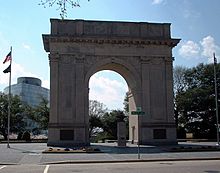
The city's downtown area was the first part to be developed. It includes the shipyard and coal piers. Over time, the city grew westward and northward.
West of downtown, there's an older area called Huntington Heights, also known as the North End. This area has many interesting old buildings from 1900 to 1935 and offers great views of the James River. It's even listed on the National Register of Historic Places because of its history.
When Newport News and Warwick merged in 1958, the city expanded a lot. Much of the city became more suburban, with many neighborhoods built where farms and woods used to be. You can find beautiful homes along the James River and its smaller waterways.
In the far northwestern part of the city, you'll find large natural areas like the reservoirs of the Newport News Water System and the huge Newport News Park. This area also includes military bases like Fort Eustis.
Downtown Newport News has the Victory Arch, built to remember World War I. City leaders are working to bring new life to this area.
Newer business areas have grown along Warwick Boulevard and Jefferson Avenue. Places like Oyster Point, Kiln Creek, and the City Center are examples of modern developments. The City Center is often called the "new downtown" because of its central location.
Newport News also has a small Korean community on Warwick Boulevard, sometimes called "Little Seoul." It's a place where the Hampton Roads Korean community gathers.
Neighborhoods in Newport News
Newport News has many unique neighborhoods, each with its own feel. Some of these include:
- Brandon Heights
- Brentwood
- City Center
- Colony Pines
- Christopher Shores-Stuart Gardens
- Denbigh
- Glendale
- East End
- Hidenwood
- Hilton Village
- Hunter's Glenn
- Beaconsdale
- Ivy Farms
- North End Huntington Heights
- Jefferson Avenue Park
- Kiln Creek
- Lee Hall
- Menchville
- Maxwell Gardens
- Morrison (also known as Gum Grove)
- Newmarket Village
- Newsome Park
- Oyster Point
- Parkview
- old North Newport News (Center Ave. area)
- Port Warwick
- Richneck
- Riverside
- Shore Park
- Summerlake
- Village Green
- Windsor Great Park
- Warwick
Newport News Weather
Newport News has a humid subtropical climate. This means it has cool to mild winters and hot, humid summers. On average, it gets about 5.8 inches (14.7 cm) of snow each winter. Summers tend to be a bit wetter than other seasons.
| Climate data for Newport News, Virginia (1981–2010 normals) | |||||||||||||
|---|---|---|---|---|---|---|---|---|---|---|---|---|---|
| Month | Jan | Feb | Mar | Apr | May | Jun | Jul | Aug | Sep | Oct | Nov | Dec | Year |
| Mean daily maximum °F (°C) | 49.5 (9.7) |
52.9 (11.6) |
60.7 (15.9) |
71.1 (21.7) |
78.5 (25.8) |
86.2 (30.1) |
89.6 (32.0) |
87.4 (30.8) |
82.2 (27.9) |
72.5 (22.5) |
63.3 (17.4) |
53.4 (11.9) |
70.6 (21.4) |
| Mean daily minimum °F (°C) | 31.8 (−0.1) |
32.6 (0.3) |
39.5 (4.2) |
47.8 (8.8) |
57.0 (13.9) |
66.3 (19.1) |
70.3 (21.3) |
68.8 (20.4) |
62.7 (17.1) |
51.7 (10.9) |
43.0 (6.1) |
34.6 (1.4) |
50.5 (10.3) |
| Average precipitation inches (mm) | 3.33 (85) |
3.01 (76) |
3.44 (87) |
3.33 (85) |
3.74 (95) |
3.81 (97) |
4.71 (120) |
5.35 (136) |
4.79 (122) |
3.47 (88) |
3.08 (78) |
3.38 (86) |
45.44 (1,155) |
| Average snowfall inches (cm) | 2.4 (6.1) |
2.1 (5.3) |
0.3 (0.76) |
0 (0) |
0 (0) |
0 (0) |
0 (0) |
0 (0) |
0 (0) |
0 (0) |
0 (0) |
1.0 (2.5) |
5.8 (14.66) |
| Average precipitation days (≥ 0.01 in) | 10.4 | 9.5 | 10.6 | 10.1 | 10.6 | 9.9 | 11.1 | 10.1 | 8.8 | 7.6 | 8.5 | 9.8 | 116.8 |
| Average snowy days (≥ 0.1 in) | 1.6 | 1.3 | 0.4 | 0.1 | 0 | 0 | 0 | 0 | 0 | 0 | 0 | 0.5 | 3.9 |
| Mean monthly sunshine hours | 170.5 | 178.0 | 229.4 | 252.0 | 272.8 | 279.0 | 279.0 | 260.4 | 231.0 | 207.7 | 177.0 | 161.2 | 2,698 |
| Source: NOAA (temperature and total precipitation normals at Newport News Int'l, all others at Norfolk Int'l), HKO (sun only 1961–1990) | |||||||||||||
Who Lives in Newport News?
| Historical population | |||
|---|---|---|---|
| Census | Pop. | %± | |
| 1890 | 1,234 | — | |
| 1900 | 19,635 | 1,491.2% | |
| 1910 | 20,205 | 2.9% | |
| 1920 | 35,596 | 76.2% | |
| 1930 | 34,417 | −3.3% | |
| 1940 | 37,067 | 7.7% | |
| 1950 | 42,358 | 14.3% | |
| 1960 | 113,788 | 168.6% | |
| 1970 | 138,177 | 21.4% | |
| 1980 | 144,903 | 4.9% | |
| 1990 | 170,045 | 17.4% | |
| 2000 | 180,150 | 5.9% | |
| 2010 | 180,719 | 0.3% | |
| 2020 | 186,247 | 3.1% | |
| U.S. Decennial Census 1790–1960 1900–1990 1990–2000 2018 Estimate 2020 |
|||
In 2020, the population of Newport News was 186,247. The city is home to people from many different backgrounds.
Population Makeup
| Race / Ethnicity (NH = Non-Hispanic) | Pop 2000 | Pop 2010 | Pop 2020 | % 2000 | % 2010 | % 2020 |
|---|---|---|---|---|---|---|
| White alone (NH) | 93,624 | 83,153 | 71,250 | 51.97% | 46.01% | 38.26% |
| Black or African American alone (NH) | 69,538 | 71,727 | 76,870 | 38.60% | 39.69% | 41.27% |
| Native American or Alaska Native alone (NH) | 685 | 682 | 571 | 0.38% | 0.38% | 0.31% |
| Asian alone (NH) | 4,112 | 4,858 | 6,230 | 2.28% | 2.69% | 3.35% |
| Pacific Islander alone (NH) | 199 | 284 | 404 | 0.11% | 0.16% | 0.22% |
| Some Other Race alone (NH) | 356 | 308 | 1,124 | 0.20% | 0.17% | 0.60% |
| Mixed Race or Multi-Racial (NH) | 4,041 | 6,117 | 10,510 | 2.24% | 3.38% | 5.64% |
| Hispanic or Latino (any race) | 7,595 | 13,590 | 19,288 | 4.22% | 7.52% | 10.36% |
| Total | 180,150 | 180,719 | 186,247 | 100.00% | 100.00% | 100.00% |
In 2010, there were about 180,719 people living in Newport News. The city had about 69,686 households. The population was made up of different racial groups, including White, African American, Native American, Asian, and Pacific Islander. Many people were also of Hispanic or Latino background.
Newport News' Economy

Newport News has several important industries. These include shipbuilding, military support, and aerospace.
Major Industries and Employers
- Shipbuilding: Newport News Shipbuilding, owned by Huntington Ingalls Industries, is a huge shipyard. It builds and repairs ships, especially for the U.S. Navy.
- Military: Many people in Newport News work for the military or for companies that supply military bases. Joint Base Langley–Eustis is a large military installation nearby.
- Transportation: The city is a key hub for moving goods. The Newport News Marine Terminal is where trains from CSX Transportation (a big railroad company) meet ships. This allows coal and other goods to be transported across the country and overseas.
- Research: The Thomas Jefferson National Accelerator Facility (TJNAF) is located in Newport News. It's a science facility where over 2,000 scientists from around the world do research to understand the basic structure of matter.
The largest employer in Newport News is Newport News Shipbuilding, with over 24,000 employees. Fort Eustis is the second largest, employing over 10,000 people. The Newport News School System is the third largest employer, with over 5,000 jobs.
Other companies based in Newport News include Ferguson Enterprises and L-3 Flight International Aviation.
Culture and Fun in Newport News

Newport News has a rich history and many interesting places to visit.
Museums and History
- The Mariners' Museum: This is one of the best maritime museums in the world. It has about 32,000 items, including ship models, paintings, and old ship parts. The museum also has a large park with a lake and trails.
- Virginia War Museum: This museum tells the story of American military history. It has weapons, vehicles, uniforms, and even a piece of the Berlin Wall.
- U.S. Army Transportation Museum: Located at Fort Eustis, this museum shows the history of how the Army moves its supplies and troops. It has nearly 100 military vehicles, including land vehicles, boats, and trains.
- Lee Hall Mansion: This historic home from 1859 played a role in the American Civil War.
- Endview Plantation: Another historic plantation that was important during the Civil War.
Arts and Entertainment
- Ferguson Center for the Arts: This is a modern theater and concert hall on the campus of Christopher Newport University. It hosts many different shows and concerts.
- Port Warwick Art and Sculpture Festival: This annual festival brings together artists who show and sell their work in Styron Square.
- Virginia Living Museum: This unique museum combines a wildlife park, science museum, aquarium, and planetarium. You can see native animals and learn about science and nature.
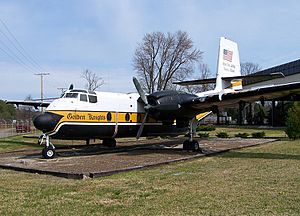
Parks and Outdoor Activities
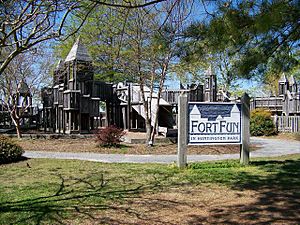
Newport News has 32 city parks! They range in size from very small to very large.
Newport News Park
The biggest park is Newport News Park, which is huge at 7,711 acres (31 square kilometers). It has:
- A golf course.
- Camping areas.
- Over 30 miles (48 km) of trails for walking and biking.
- A 5.3-mile (8.5 km) bike path (helmets are required for kids under 14).
- An archery range.
- A disc golf course.
- An "aeromodel flying field" for remote-controlled aircraft.
Boat Ramps and Piers
The city also has two public boat ramps:
- Denbigh Park Boat Ramp: This gives you access to the Warwick River and has a small fishing pier.
- Hilton Pier/Ravine: This pier has a small beach and is good for fishing. It's also accessible for people in wheelchairs.
Sports in Newport News
Newport News is home to many sports activities.
College and High School Sports
- Christopher Newport University Captains: The university has 14 sports teams that compete in Division III of the NCAA.
- High School Sports: Football is very popular in Newport News high schools. Games are often played at John B. Todd Stadium, which also hosts track and field events.
Other Sports
- Lionsbridge FC: This is a professional soccer club that plays at Christopher Newport University during the summer.
- One City Marathon: Since 2015, Newport News has hosted an annual marathon. The race starts in Newport News Park and finishes at the Victory Arch downtown. There are also shorter races like a half marathon and an 8K.
Learning in Newport News
Newport News has many schools and universities for students of all ages.
Public Schools
The main public school system is Newport News Public Schools. It includes many elementary schools, six middle schools, and five high schools:
- Denbigh High School
- Heritage High School
- Menchville High School
- Warwick High School
- Woodside High School
All middle, high, and elementary schools are fully accredited. Some schools offer special programs, like a Talented and Gifted program at Dutrow Elementary and a STEM (Science, Technology, Engineering, Math) program at Crittenden Middle School. Warwick High School is known for its IB (International Baccalaureate) program.
Private Schools
There are also several private schools in the area, such as:
- Denbigh Baptist Christian School
- Hampton Roads Academy
- Peninsula Catholic High School
- Trinity Lutheran School
Colleges and Universities
- Christopher Newport University: This is a public university located in Newport News.
- The Apprentice School: Operated by Newport News Shipbuilding, this school teaches various trades related to shipbuilding.
- Virginia Peninsula Community College: This community college offers college and career training programs.
Religion in Newport News
Newport News has a variety of religious groups. The oldest church, First Church of Newport News (Baptist), was started in 1863. Because of the railroad connections, many Mennonites settled in the area and formed a community. Several synagogues were also established in the city.
Media and News
Newport News has its own ways for people to get news and information.
Local TV and Radio
The City of Newport News runs two local TV channels, Newport News Television (NNTV) and NNTV2. These channels show local events, city council meetings, and information for residents. NNTV also has a YouTube channel.
Newport News is part of the Hampton Roads TV market, so you can also watch major network channels like CBS, NBC, ABC, Fox, and PBS.
The city is served by many radio stations on both AM and FM.
Newspapers and Magazines
The daily newspaper for Newport News is the Daily Press. Other local papers include the Port Folio Weekly and the New Journal and Guide.
Hampton Roads Magazine is a magazine that covers Newport News and the wider Hampton Roads area.
Getting Around Newport News
Newport News has a good transportation system, including highways, bridges, trains, buses, and an airport.
Airports
- Newport News/Williamsburg International Airport: This is the main airport for the Virginia Peninsula. It has flights to various destinations.
- Norfolk International Airport: This larger airport is located nearby in Norfolk and Virginia Beach, offering flights to many cities.
Trains
Amtrak provides train service to Newport News, with trains running west to Richmond and beyond.
Buses
Greyhound Lines offers intercity bus service from the station on Warwick Boulevard. For getting around the city and to other nearby cities in Hampton Roads, there's a regional bus service called Hampton Roads Transit.
Water and Utilities
The Newport News Waterworks provides water to over 400,000 people in Newport News and nearby areas. It was started by Collis P. Huntington as part of the city's early development. The city also handles wastewater services for its residents.
Famous People from Newport News
Sister Cities
Newport News has special connections with cities in other countries, called "sister cities":
 Neyagawa, Osaka, Japan
Neyagawa, Osaka, Japan Taizhou, Jiangsu, China
Taizhou, Jiangsu, China Greifswald, Mecklenburg-Vorpommern, Germany
Greifswald, Mecklenburg-Vorpommern, Germany
Newport News is also working to add Carrigaline, County Cork, Ireland as a sister city.
Images for kids
-
Lee Hall, built in 1859 by Richard Lee
See also
 In Spanish: Newport News para niños
In Spanish: Newport News para niños






